Prime
My Volkswagen Transporter T3 is priceless - Ssemwanga

Ssemwanga observes that the VW Transporter T3 offers extra comfort off-road because of the springs it comes with in the seats, coupled with strong shock absorbers. Photos by Roland Nasasira
What you need to know:
- A look at the initial registered vehicle particulars of Emmanuel Ssemwanga’s Volkswagen (VW) Transporter Type 3 (T3) station wagon shows that it was first owned by the Ministry of Health in 1987 when it was brought into the country
After 10 years, the ministry disposed it off in 1997 to Medi Kasagga who changed its registration number plate from the government’s UM 0399, to 458 UDA on March 11 1997.
At the time, it had its initial cream colour. In June 2015, Emmanuel Ssemwanga found the car grounded in Masaka and bought it at Shs4.8m. He then transported it using a car carrier to a garage in Wankulukuku for restoration. Ssemwanga has since held the VW Transporter T3 dearly to him. He also changed its number plate to UBE 573W.
Restoring the car
Ssemwanga reveals that restoring the car cost him more than buying it did. The engine cost him Shs3.8m while the body work, including spraying and panel beating cost Shs2m. Other things such as the wiring system cost approximately Shs2.5m. On average, the total restoration cost came to approximately Shs12m, including labour.
“After repairing the engine, I realised its original engine of 1600c was defunct. I replaced it with an 1800cc VW Golf 3 engine . When restoration was complete, the car became a darling not only to me but to many other people who wave at me when I get on the road,” Ssemwanga says.
Specifications
Ssemwanga’s VW Transporter T3 is a 1987 petrol-engine run seven seater model. He uses the van to do a number of things. He sometimes loads it with merchandise when the rear seats are removed and loads the extra on the roof rack, uses it to carry farm produce and also as a passenger car.
When he travels upcountry to Mityana for family functions, the car is turned into a house where he or any other family members sleep.
The van comes fitted with foot and hand brakes and safety belts at the front as the only safety features. The back seats did not come with seatbelts.
Service and maintenance
Ssemwanga buys some spare parts locally in Ndeeba, but he sometimes, buys from neighbouring Kenya.
For example, with crucial parts such as the clutch, are sourced from Kenya because, according to him, the ones in Uganda are recycled. Servicing the VW Transporter T3 also depends on mileage covered because it is not a car that Ssemwanga drives regularly.

“I service it after four months,” he says. The farthest he has driven the car is from Kampala to Mbarara although he has also driven the 140km maximum speed van to Hoima and Mityana, among other places. The highest speed he has driven at was 120km/hr. On a highway, it covers nine kilometers using one litre and seven kilometers using one litre in urban areas.
Other models and performance
The VW Transporter Type 3 (T3) is the newer model of the VW Kombis. The VW Transporter was manufactured in Transporter T1, T2, T3, T4, T5 upto the current T6. The Transporter T1 was manufactured from 1950 to 1967, before the T2 were released from 1967 to 1979.
This was followed by T3 whose production started in 1979 to 1992, a period under which Ssemwanga’s was also produced. The T4 then followed from 1990 to 2003. This was shortly followed by the T5 from 2003 to 2016. The latest T6 were manufactured from 2016 to present and look more and have similar shapes like the Toyota Alphard, Nissan Elgrand and the Toyota Super Custom.
Advantages of the T3
One special thing about Ssemwanga’s T3 is that it can take on any kind of terrain. It is made of pure metal with very little plastic. Compared to the Toyota Super Custom, Ssemwanga observes that the VW Transporter T3 offers extra comfort off-road because of the springs it comes with in the seats, coupled with strong shock absorbers.
“I encourage people to restore such cars. Their metal element makes them easy to panel beat if you want to rebuild them . Once you have done the right restoration, it will give you good mileage in terms of durability. It is a reliable car,” Ssemwanga advises.
“You will not hear of someone losing such a car to theft. They do not have a resale value so stealingh them is pointless. If you own it, you will have it till death do you part,” he adds. On how much he would charge if he decided to sell it off, Ssemwanga says he once checked out the market value. He found some car enthusiasts who offered Shs35m, an amount he was not comfortable with.
“It is not about the money, but the attachment you have to it, where it came from, where you have moved with it and how far you think you will go with it. For such a car, there is no good amount of money you can accept,” Ssemwanga notes.




